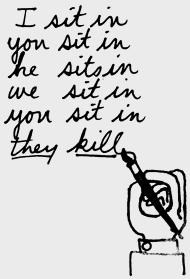April Third Movement
About the Stanford Movement
1965–1975
The movement at Stanford University against the Vietnam War emerged as a significant force in 1965 and continued through the end of the war in 1975. It overlapped with the civil rights/Third World liberation movement, women’s liberation, the counter-culture, gay rights, labor organizing, university reform, anti-draft work, anti-imperialism, and several version of socialism to form what we called the Movement, but anti-war activity was the largest and most sustained thread.
The Stanford anti-war movement was particularly effective, militant, and persistent because we linked our opposition to the war in Southeast Asia to the roles that Stanford and associated institutions played in conducting that war. We researched those connections, wrote pamphlets, led classes, held teach-ins, and organized dorm meetings. We took actions that included peaceful picketing, campus elections, class boycotts, guerilla theater, civil disobedience, “trashing,” and street warfare. And we had many meetings, large and small.
In October 1968, members of Stanford SDS (Students for a Democratic Society) nailed the following demand to the door of the university president’s office in Inner Quad with a “golden spike”:
WE, the members of Stanford SDS and concerned members of the Stanford community, DEMAND that Stanford University, its wholly owned subsidiary, the Stanford Research Institute, and all members of the university community immediately halt all military and economic projects and operations concerned with Southeast Asia.
That demand laid the foundation for the April Third Movement (A3M), one of the highlights of the anti-war decade at Stanford. Formed at a community meeting in Dinkelspiel Auditorium on April 3, 1969, A3M staged a nine-day sit-in at the Applied Electronics Laboratory, briefly occupied the Encina Hall administration building, and blockaded the Stanford Research Institute’s counterinsurgency offices in the Stanford Industrial Park. The following year many of the same activists mounted the “Off ROTC” campaign against the Reserve Officer Training Corps, which grew into the Stanford version of the national student strike in response to the U.S. invasion of Cambodia—a combination of daytime marches, night-time confrontations with police, teach-ins, and the early end to Spring quarter.
The Movement put an end to classified research at Stanford and forced ROTC off campus; and we believe that along with similar movements—among students, GIs, and others—it hastened an end to the war.
Equally important, by attracting our classmates to the anti-war, New Left cause, we had a lasting impact on American society. Many people who took part in our sit-ins and street demonstrations became progressive leaders in academia, the professions, the labor movement, and politics. They helped transform computers from captive tools of the military and large corporations to the technologies that today serve us all.
